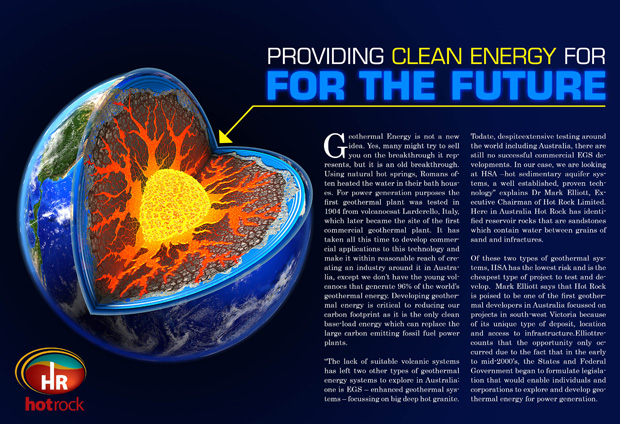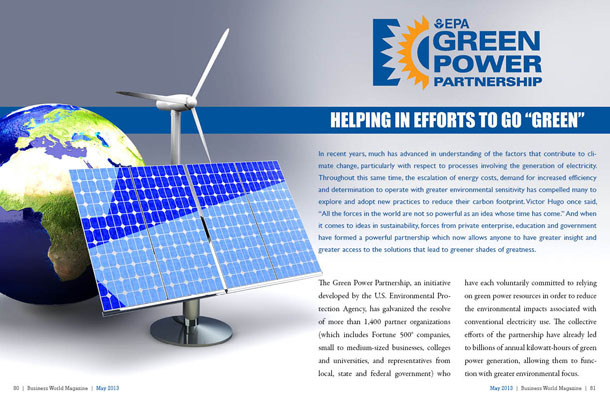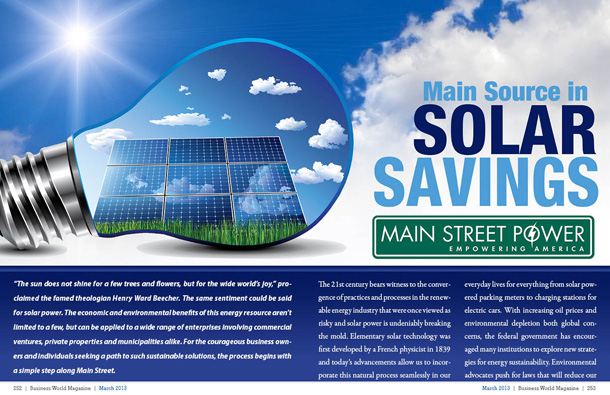
Providing clean energy for the future

Geothermal Energy is not a new idea. Yes, many might try to sell you on the breakthrough it represents, but it is an old breakthrough. Using natural hot springs, Romans often heated the water in their bath houses. For power generation purposes the first geothermal plant was tested in 1904 from volcanoesat Larderello, Italy, which later became the site of the first commercial geothermal plant. It has taken all this time to develop commercial applications to this technology and make it within reasonable reach of creating an industry around it in Australia, except we don’t have the young volcanoes that generate 96% of the world’s geothermal energy. Developing geothermal energy is critical to reducing our carbon footprint as it is the only clean base-load energy which can replace the large carbon emitting fossil fuel power plants.
“The lack of suitable volcanic systems has left two other types of geothermal energy systems to explore in Australia: one is EGS – enhanced geothermal systems – focussing on big deep hot granite.Todate, despiteextensive testing around the world including Australia, there are still no successful commercial EGS developments. In our case, we are looking at HSA -hot sedimentary aquifer systems, a well established, proven technology” explains Dr Mark Elliott, Executive Chairman of Hot Rock Limited. Here in Australia Hot Rock has identified reservoir rocks that are sandstones which contain water between grains of sand and infractures. Of these two types of geothermal systems, HSA has the lowest risk and is the cheapest type of project to test and develop.
Mark Elliott says that Hot Rock is poised to be one of the first geothermal developers in Australia focussed on projects in south-west Victoria because of its unique type of deposit, location and access to infrastructure.Elliottrecounts that the opportunity only occurred due to the fact that in the early to mid-2000’s, the States and Federal Government began to formulate legislation that would enable individuals and corporations to explore and develop geothermal energy for power generation.
“What we are seeing in Australia today are companies that are all start-ups, that are exploring projects for the first time and hope to be able to move forward to develop them.
“In our particular case, we applied for ground in Victoria in 2006 that contained similar features to commercial geothermal projects overseas, notably in California.We were successful in acquiring the projects we wanted in the Otway Basin, south west Victoria.”
Elliott says that their ideal location is a significantadvantage that many other projects do not have. With closeproximity to major infrastructure and populations, their first commercial plantwill be able to supply local communities with zero emission power. Elliott says that by late 2007 they had fully prepared themselves to move into the corporate world and floated Hot Rock Limited on the Australian stock exchange under the code HRL.
Building on conventional energy sources
South-west Victoria contains exciting targets for the discovery of HSA geothermal systems.Right now, Hot Rock has outlined three projects in the Otway Basin.
“Our project’s location provides access to a population of five million within a state that has the highest carbon emissions per capita in Australia.We are located near the national electricity transmission grid, minimising the infrastructure required to connect to our markets.
“If all our Victorian projects are developed, they will be able to serve 35 per cent of Victoria’s energy needs with near zero emission, clean, renewable energy.
“Wehave identified three separate development sites: Koroit, Penola, and Tantanoola.Our flagship Koroit Project near Warrambool, alone has a 1000 megawatt potential, sufficient to power 1 million households.These are very large volumes of fractured sedimentary rocks ready to supply hot water to a conventional power plant on the surface.”
At Koroit, seismic surveys carried out by the petroleum industry have enabled Hot Rock to outline a suitable geothermal reservoir full of hot water at a depth of 3 to 4km below the surface.Within the project area there are 14 petroleum wells some of which have recorded direct temperature measurements in the geothermal reservoir indicating commercial production temperatures of 150oC can be obtained.However, the company still needs to drill geothermal wells to test the amount of hot fluid we can bring to surface to produce electricity.
Emerging clean energy technologies are also about driving down capital and operating costs.Hot Rock is already looking at new generation drilling rigs to significantly reduce costs, which, according to Elliott, will greatly reduce the initial cost of the total project costs, and thereby, enabling lower electricity prices.
Elliott believes the Koroit Project is one of the best near term undeveloped HSA’s projects in Australia.”We intend to drill into these reservoirs full of hot water to bring that water to the surface in order to put it through apower plant. When the water exits the plant, it can be used for a range of new applications such as hot houses for growing flowers or vegetables and the water is then re-injected into the same reservoir from where it was sourced.”
Elliott himself has been an economic geologist for the last 35 years, focusing on the mineral and energy sectors. In these endeavours he has established himself as a market leader and an innovator. He is somewhat tight-lipped about his accomplishments, but his record shows that he has been at the helm of several successful resource related endeavours.
The similarities between the oil and gas industries is that they used the same tried and tested drilling equipment, and Elliott is quick to point out that a lot of the green power industry would be nowhere without the innovations of conventional power sources.
“These drilling programs are very expensive, and since they are at a very early stage, it has been difficult attracting the necessary funds from government or private enterprise,” says Elliott.
He views the geothermal energy sector as something very new, and with that newness he has found that investors and brokers are hesitant to take early stage risk.
“To drill two exploration wells to a depth of 3,700m will require a $23 million proof of concept program.For each production well that we drill, we expect to recover about 7 megawatts per-well.This is about the energy it takes to power a single heavy locomotive. In comparison, nuclear power plants produce about 500 to 1300 MW.”
Each well drilled will take Hot Rock closer to the goal of sustainable power supply.The thing that he says has blocked much of the progress of the burgeoning industry is that funding from government agencies has been too little for companies to advance high cost drilling projects.Elliott says that the projects are very expensive, and due to their drill depths these costs increase the deeper they have to go.
“The recently announced Federal government’s carbon tax scheme and commitment to provide $13.2 billion in funding to the renewable energy industry is great news for the geothermal industry.Hot Rock is well placed to take advantage of the government new funding initiative, with the first project at Koroit ready to drill and test.If the test work is positive this information would be used for their feasibility study. This will let us finance and move forward on to build 50 to 100 megawatt sized power stations by 2015,” he says.
The right place at the right time
Elliott estimates that with the new government support,they couldhave a completed project ready by 2015. He continues to stress the importance geothermal energy for the future of Australia.
“The introduction of a carbon price and clean energy fund is a step in the right direction, but Australia has to also look at models from abroad that can be adapted for local use. The real struggle for renewable energy companies like Hot Rock is securing the interest of the Australian investing public. The technology is proven, safe, and does not depend on weather or environment. Hot Rock has established what is possible, but needs the support of government, investors, and those with a stake in Australia’s future to step up and make it happen.HSA geothermal has been largely overlooked by both government funding bodies and investors interest in the past, but this is about to change with new government funding opportunities and future anticipated successes.”
While Hot Rock has been waiting for the Federal government to get its climate change and renewable energy funding programs sorted out for its Australian projects to be able to advance, it has been operating in world-class conventional volcanic terrains in South America for over 2 years and has already secured 10 projects in Chile and Peru. Attractive power prices, government support and legislation for geothermal energy in these countries will see Hot Rock develop significant overseas generationwithin the next 3-4 years. Hot Rock has the projects in Australia and overseas to build a large, clean energy,power company, and it is ideally suited for major growth in a future carbon constrained world, hungry for clean base-load power.







